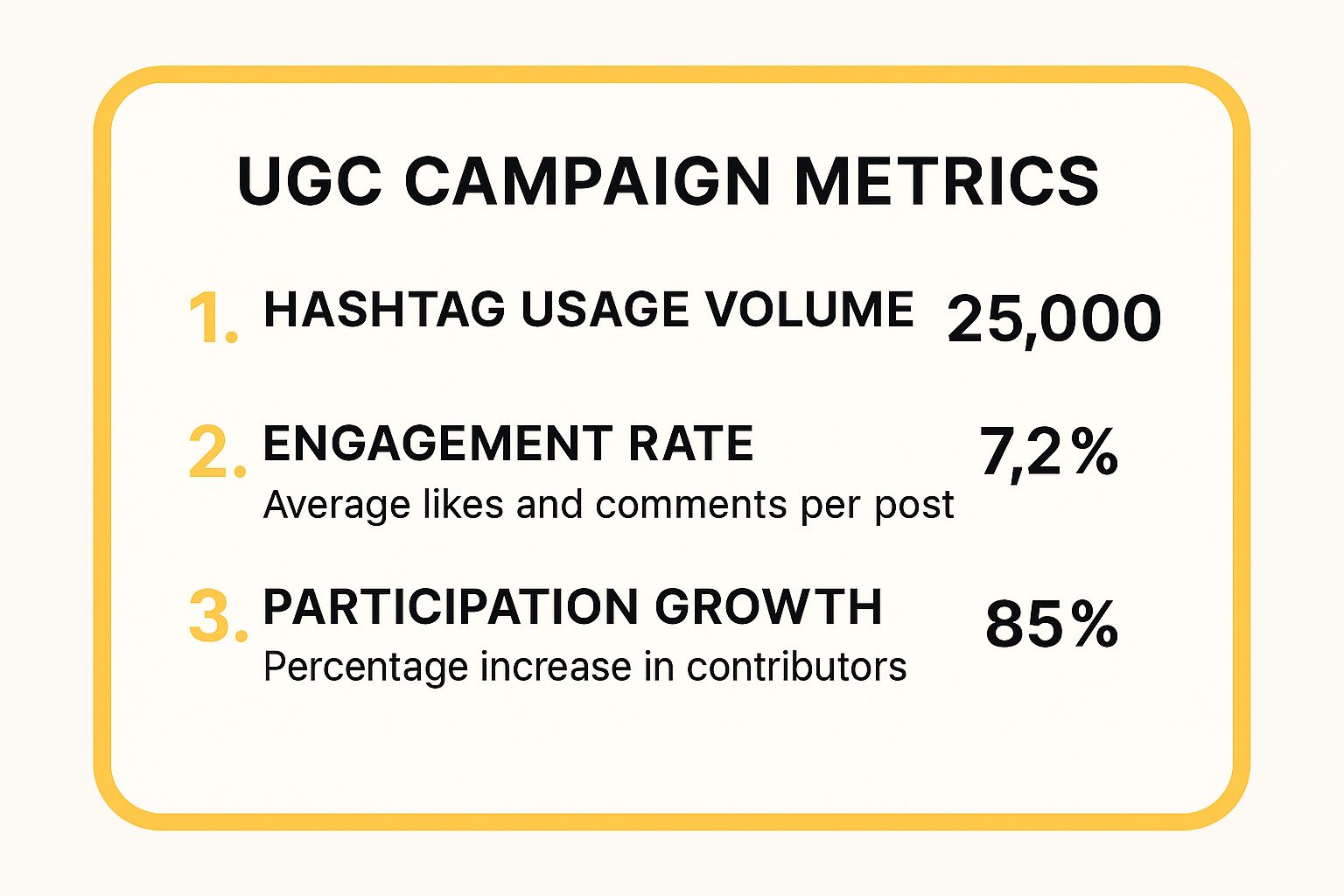In a competitive online space, a well-defined strategy is the difference between shouting into the void and building a loyal community that drives real business results. The challenge isn't a lack of ideas but knowing which tactics actually move the needle. This guide cuts through the noise, providing a deep dive into proven social media marketing strategy examples you can adapt for your own business. We'll move beyond surface-level descriptions to dissect the specific actions, analyze the outcomes, and extract actionable takeaways for your team.
Developing a comprehensive social media posting strategy playbook is essential, serving as your brand's blueprint for a powerful online presence. The examples below bring those foundational concepts to life, showing you how to execute them effectively.
From harnessing user-generated content and building authentic influencer partnerships to integrating social commerce and mastering real-time engagement, this article is designed for tangible results. We'll explore campaigns that excelled at:
- User-Generated Content (UGC) Campaigns
- Influencer Partnership Marketing
- Social Commerce Integration
- Real-Time Social Listening and Response
- Community Building and Engagement
- Educational Content Marketing
- Omnichannel Social Media Integration
Let’s examine the strategies that transform passive followers into active customers.
1. User-Generated Content (UGC) Campaigns
User-Generated Content (UGC) campaigns are a powerful type of social media marketing strategy where brands encourage their audience to create and share content. Instead of the brand creating all its own marketing materials, it leverages authentic posts from real customers, turning them into brand advocates. This approach builds a strong sense of community and provides valuable social proof.
For example, GoPro built its entire brand identity by featuring thrilling videos submitted by its users. Similarly, Coca-Cola's "Share a Coke" campaign invited people to find bottles with their names and share photos, creating a massive, personalized, and organic marketing wave. These campaigns succeed because they tap into a fundamental human desire to share experiences.
Strategic Analysis and Tactical Breakdown
The core of a successful UGC campaign is a simple, compelling call-to-action paired with a clear incentive. The goal is to make participation feel less like marketing and more like joining a movement. This strategy excels at building trust, as content from a peer is often perceived as more authentic than a polished brand advertisement.
Key Strategic Insight: UGC transforms your customers from passive consumers into active co-creators of your brand's story. This deepens their loyalty and organically expands your reach through their personal networks, creating a cycle of authentic engagement.
Actionable Takeaways for Your Business
To replicate this success, you can implement a similar approach tailored to your brand.
- Create a Clear Hashtag: Develop a unique, memorable hashtag that is easy to spell and directly related to your campaign, like Starbucks'
#RedCupContest. - Offer Meaningful Incentives: Reward participants with more than just a "like." Offer prizes, discounts, or feature the best submissions on your official channels to motivate participation.
- Establish and Promote Guidelines: Clearly communicate the rules. Let users know what kind of content you’re looking for and any specific requirements to ensure submissions align with your brand values.
- Engage Actively: Don't just launch the campaign and wait. Actively monitor the hashtag, engage with submissions by commenting and sharing, and make participants feel seen and valued.
The following infographic highlights the key metrics to track when measuring the impact of a UGC campaign.

Tracking these metrics provides a clear picture of your campaign's reach, resonance, and ability to attract new contributors over time.
2. Influencer Partnership Marketing
Influencer Partnership Marketing is a collaborative strategy where brands partner with social media influencers to promote products or services. This approach leverages the influencer's established credibility and engaged audience, tapping into a pre-built community of trust. Instead of direct advertising, the brand's message is delivered through a familiar, trusted voice, making it feel more like an authentic recommendation than a sales pitch.
For example, watch brand Daniel Wellington grew into a multi-million dollar company by pioneering a micro-influencer strategy. They sent free watches to thousands of influencers, who posted photos with a unique discount code. Similarly, Gymshark built its empire by sponsoring fitness athletes and influencers, turning them into long-term brand ambassadors who authentically integrated the apparel into their content. These examples of social media marketing strategy demonstrate how partnerships can generate massive ROI.
Strategic Analysis and Tactical Breakdown
The power of influencer marketing lies in its ability to borrow trust. An influencer has spent years building a relationship with their audience, and a brand can tap into that connection instantly. This strategy is particularly effective for reaching niche demographics and driving conversions, as a recommendation from a trusted source carries significant weight. The key is finding an influencer whose personal brand and audience align perfectly with your own.
Key Strategic Insight: Influencer partnerships trade the broad, impersonal reach of traditional advertising for the deep, targeted influence of a trusted personality. This creates a powerful form of social proof that can drive immediate action and build lasting brand affinity.
Actionable Takeaways for Your Business
To effectively implement an influencer partnership strategy, focus on authenticity and mutual value.
- Prioritize Alignment Over Reach: Choose influencers whose audience demographics, values, and content style genuinely match your brand. A smaller, highly engaged audience is often more valuable than a massive, disconnected one.
- Grant Creative Freedom: Provide clear guidelines and campaign goals, but allow the influencer creative control to ensure the content feels natural to their audience. Forced, overly scripted promotions are easily spotted and ignored.
- Build Long-Term Relationships: Shift from one-off transactional posts to long-term ambassadorships. Sustained partnerships feel more authentic and allow for deeper storytelling, strengthening brand association over time.
- Track Performance Beyond Likes: Measure success with metrics tied to your goals, such as conversion rates from unique discount codes, website referral traffic, and audience sentiment in the comments. Ensure all partnerships comply with FTC disclosure guidelines.
3. Social Commerce Integration
Social Commerce Integration is a strategy that transforms social media platforms into direct sales channels by seamlessly embedding shopping features. This approach merges content discovery with the purchasing process, allowing consumers to buy products directly within platforms like Instagram, Facebook, or TikTok without being redirected to an external website. It effectively shortens the sales funnel and capitalizes on impulse buys.
For example, a fashion brand can use Instagram's Shopping feature to tag products in a post or Story. A user can tap the tag to see product details and pricing, then proceed to checkout directly within the app. Similarly, Pinterest’s Product Rich Pins and TikTok's Shopify integration allow brands to create a native, frictionless shopping experience that feels like a natural part of the user's browsing journey.

Strategic Analysis and Tactical Breakdown
The power of social commerce lies in its ability to eliminate friction between inspiration and transaction. By making the path to purchase as short as possible, brands can capture customers at the peak of their interest. This strategy is one of the most effective social media marketing strategy examples for e-commerce businesses looking to boost conversion rates and tap into the massive, engaged audiences on social platforms.
Key Strategic Insight: Social commerce turns your social media profiles into dynamic, shoppable storefronts. It shifts the focus from simply driving traffic to an external site to creating an integrated ecosystem where content, community, and commerce coexist.
Actionable Takeaways for Your Business
Implementing a social commerce strategy requires more than just enabling a shop feature; it demands a thoughtful approach to content and user experience.
- Optimize Product Catalogs: Ensure your product feeds are up-to-date with high-quality images, accurate pricing, and compelling, mobile-friendly descriptions tailored to each platform.
- Create Shoppable Lifestyle Content: Showcase products in authentic, real-world contexts rather than just using standard product shots. Use videos, Reels, and user-generated content to demonstrate value.
- Leverage Platform-Specific Features: Use Instagram's product stickers in Stories, create dedicated Shop tabs on Facebook, and utilize TikTok's live shopping capabilities to engage customers directly.
- Promote Your Social Storefront: Actively drive traffic to your social shops through ads, influencer collaborations, and clear calls-to-action in your bio and posts. Learn more about how a strong e-commerce foundation supports this strategy.
4. Real-Time Social Listening and Response
Real-Time Social Listening and Response is a proactive strategy where brands monitor social media for mentions and conversations related to their business, then engage in those conversations as they happen. This approach allows brands to manage their reputation, provide immediate customer support, and capitalize on viral trends, turning social media into a dynamic two-way communication channel.
A classic example is Oreo's "You can still dunk in the dark" tweet during the 2013 Super Bowl blackout. While competitors were silent, Oreo's team reacted within minutes, earning massive organic reach. Similarly, Wendy's has built a unique brand personality through witty, real-time Twitter roasts and interactions, transforming customer engagement into entertainment. These social media marketing strategy examples demonstrate the power of being agile and relevant.
Strategic Analysis and Tactical Breakdown
The core of this strategy is preparedness and agility. It requires having a team and tools in place to listen, evaluate, and respond almost instantly. This approach excels at humanizing a brand, making it appear more authentic, aware, and responsive to its audience. It shifts the brand from a broadcaster to an active participant in cultural conversations.
Key Strategic Insight: Real-time engagement transforms social media from a static advertising platform into a live stage for brand personality. By joining relevant conversations at the right moment, you can generate disproportionate brand awareness and affinity that traditional campaigns cannot match.
Actionable Takeaways for Your Business
To effectively implement real-time listening and response, your business can adopt the following practices.
- Utilize Social Listening Tools: Implement tools like Brandwatch or Sprout Social to set up alerts for your brand name, keywords, and industry trends. This ensures you never miss a critical conversation.
- Establish a Clear Brand Voice and Guidelines: Define your brand's personality, tone, and what topics are on or off-limits. Empower your team with clear guidelines so they can respond quickly and confidently without lengthy approval processes.
- Create an Escalation Plan: Not all mentions are equal. Develop a clear protocol for handling negative feedback, customer complaints, or potential PR crises, specifying when to escalate an issue to senior management or other departments.
- Prioritize and Act Swiftly: Focus on conversations with the highest potential for positive impact or those that require urgent attention. In real-time marketing, speed is a significant competitive advantage.
5. Community Building and Engagement
Community building is a long-term social media marketing strategy that focuses on creating and nurturing dedicated online spaces around a brand or shared interest. Instead of just broadcasting promotional messages, this approach prioritizes building meaningful relationships with customers through consistent interaction, valuable content, and fostering member-to-member connections. The goal is to cultivate brand loyalty and transform customers into passionate advocates.

For instance, Peloton has built an incredibly loyal community around its connected fitness platform by using leaderboards, hashtags, and instructor-led groups to encourage interaction and friendly competition. Similarly, Adobe's Creative Community provides a platform for designers and creators to share work, exchange tips, and learn from one another, positioning Adobe as an indispensable hub for creative professionals. Learn more about how to improve customer engagement on UpNorthMedia.co.
Strategic Analysis and Tactical Breakdown
The essence of community building is shifting the focus from transactions to relationships. It involves creating an environment where customers feel a sense of belonging and mutual value. This strategy is highly effective for retention, as engaged community members are far more likely to remain loyal to a brand. A key aspect of effective community building involves implementing proven strategies to increase Instagram followers organically, fostering a loyal audience.
Key Strategic Insight: A dedicated community transforms your social media presence from a one-way marketing channel into a two-way conversation hub. This fosters deep-seated loyalty and provides invaluable direct feedback, turning your audience into a powerful asset for innovation and advocacy.
Actionable Takeaways for Your Business
To cultivate a thriving community around your brand, you can apply these focused tactics.
- Define Clear Guidelines and Values: Establish and communicate rules of engagement from the start to ensure the community remains a positive and safe space that reflects your brand's identity.
- Provide Exclusive Value: Offer content, early access, or special events that are only available to community members. This creates a compelling reason for people to join and stay active.
- Recognize and Celebrate Members: Regularly feature top contributors, celebrate user milestones, and acknowledge valuable input. Making members feel seen and appreciated is crucial for sustained engagement.
- Facilitate Member-to-Member Connections: Create opportunities for members to interact directly with each other, such as through dedicated forums, subgroups for specific interests, or virtual meetups.
6. Educational Content Marketing
Educational Content Marketing is a value-driven strategy where brands focus on creating and sharing informative content that helps their audience solve problems or learn new skills. Instead of direct promotion, this approach positions the brand as a trusted authority and an indispensable resource, building loyalty and credibility over time.
For example, HubSpot Academy offers free certifications and courses on everything from inbound marketing to sales, establishing itself as the go-to educational hub in its industry. Similarly, Moz’s "Whiteboard Friday" series breaks down complex SEO topics into digestible video lessons, attracting a dedicated following of marketing professionals. These brands win by prioritizing audience needs over sales pitches.
Strategic Analysis and Tactical Breakdown
The foundation of a strong educational content marketing strategy is a deep understanding of your audience's pain points. The goal is to provide genuine solutions and insights that empower them, which in turn builds a relationship based on trust. This approach excels at attracting a high-quality, engaged audience that views your brand as an expert guide.
Key Strategic Insight: Educational content shifts the brand-customer relationship from transactional to collaborative. By consistently teaching and empowering your audience, you build long-term brand equity and become the first choice when they are ready to make a purchase.
Actionable Takeaways for Your Business
To leverage this powerful social media marketing strategy, you can implement a similar value-first approach for your own brand.
- Solve Real Problems: Identify the most common questions and challenges your target audience faces. Create content like how-to guides, tutorials, or webinars that directly address these issues.
- Use Multiple Formats: Cater to different learning preferences by offering content in various formats, such as blog posts, short-form videos, infographics, and downloadable checklists.
- Share Industry Expertise: Don't be afraid to share behind-the-scenes insights or data-driven reports. This transparency demonstrates your expertise and enhances your credibility.
- Engage and Iterate: Actively monitor comments and questions on your content. Use this feedback to create follow-up material that addresses your audience's evolving needs, showing that you are listening. For more ideas on this topic, you can learn more about content marketing strategy examples at Upnorth Media.
7. Omnichannel Social Media Integration
Omnichannel social media integration is a comprehensive marketing strategy that creates a seamless, consistent brand experience across multiple social platforms and integrates them with other channels like email, websites, and even offline touchpoints. Instead of treating each channel as a separate silo, this approach ensures unified messaging while optimizing content for each platform’s unique audience.
For example, Starbucks masterfully integrates its rewards program across its mobile app, email marketing, and social media channels. A promotion announced on Instagram seamlessly directs users to the app, where they can redeem an offer that was also mentioned in an email, creating a fluid customer journey. Similarly, Nike links its social content with the Nike+ app and in-store retail experiences, encouraging a holistic brand interaction that moves effortlessly between the digital and physical worlds.
Strategic Analysis and Tactical Breakdown
The power of an omnichannel approach lies in its customer-centricity. It recognizes that modern consumers interact with brands across numerous touchpoints, and it aims to make that journey cohesive and interconnected. This strategy excels at building brand loyalty and increasing customer lifetime value by providing a consistently positive and convenient experience, regardless of the platform.
Key Strategic Insight: An omnichannel strategy shifts the focus from platform-specific campaigns to a unified customer journey. This integration makes your brand feel omnipresent and effortlessly accessible, strengthening the customer relationship and guiding them smoothly toward conversion.
Actionable Takeaways for Your Business
Implementing one of these social media marketing strategy examples requires careful planning and coordination, but it can be scaled to fit your business.
- Develop a Coordinated Content Calendar: Map out your messaging across all channels, including social media, email, and your website. Ensure themes and promotions are aligned while adapting the format for each platform.
- Maintain Core Message Consistency: While a TikTok video will differ from a LinkedIn post, the core brand message, values, and campaign goals must remain consistent. Establish clear brand guidelines that apply across all formats.
- Use Unified Tracking Systems: Implement tools like UTM parameters and integrated analytics platforms to measure cross-channel attribution. This helps you understand how different touchpoints contribute to your overall marketing goals.
- Promote Cross-Channel Engagement: Actively encourage your audience to move between platforms. For instance, promote your exclusive Instagram content in an email newsletter or use a Facebook post to drive traffic to a new blog article on your website.
7 Social Media Marketing Strategies Compared
| Strategy | Implementation Complexity 🔄 | Resource Requirements ⚡ | Expected Outcomes 📊 | Ideal Use Cases 💡 | Key Advantages ⭐ |
|---|---|---|---|---|---|
| User-Generated Content (UGC) Campaigns | Moderate: Requires content curation & moderation | Medium: Community management and incentives | High engagement, authentic trust, fresh diverse content | Brands wanting organic reach and social proof | Builds authentic trust, cost-effective, social proof |
| Influencer Partnership Marketing | High: Coordination with influencers, contracts | High: Influencer fees and campaign management | Increased brand awareness, credible endorsements | Targeted brand awareness, scalable campaigns | Access to engaged audiences, measurable ROI |
| Social Commerce Integration | High: Technical setup of catalogs & checkout | High: Platform fees, technical integration | Higher conversion rates, reduced friction in buying | E-commerce brands aiming for direct social sales | Seamless purchase experience, leverages impulse buys |
| Real-Time Social Listening and Response | High: 24/7 monitoring and immediate reactions | High: Dedicated team and advanced tools | Improved reputation, rapid crisis management | Brands needing proactive reputation management | Fast response, trend capitalization, customer care |
| Community Building and Engagement | High: Long-term ongoing engagement commitment | Medium-High: Moderation, content, events | Strong brand loyalty, advocacy, organic advocacy | Brands focusing on customer retention and loyalty | Builds emotional connection, sustainable advantage |
| Educational Content Marketing | Moderate-High: Content expertise & consistency | Medium: Content creation and expert collaboration | Authority building, trust, long-term relationships | Brands positioning as thought leaders | Builds authority, improves SEO, trust building |
| Omnichannel Social Media Integration | Very High: Coordination across many platforms | Very High: Content, tracking systems, teams | Cohesive brand experience, improved conversions | Large brands needing unified presence across channels | Maximizes reach & efficiency, seamless customer journey |
Putting Strategy Into Action
The diverse collection of social media marketing strategy examples we've explored reveals a powerful, overarching truth: success isn't about finding a single magic bullet. Instead, it's about strategically blending tactics to create a cohesive, dynamic, and audience-centric approach. From the raw authenticity of user-generated content campaigns to the targeted reach of influencer partnerships and the seamless purchasing power of social commerce, each strategy offers a unique tool for your marketing arsenal.
The most innovative brands today are not just picking one lane; they are building a multi-lane highway. They combine the community-building power of dedicated online groups with the authority of educational content marketing. They leverage real-time social listening not just for customer service, but to fuel their next campaign with relevant, timely insights. This hybrid model is the key to creating a resilient and effective social media presence that can adapt to changing trends and audience behaviors.
From Inspiration to Implementation: Your Next Steps
Viewing these examples is the first step, but turning that inspiration into tangible results requires a clear plan. The journey from observing successful social media marketing strategy examples to executing your own is built on a foundation of clear objectives and consistent measurement.
Here’s how you can begin translating these concepts into a concrete plan for your Omaha-based business or e-commerce platform:
- Define a Single, Primary Goal: Don't try to achieve everything at once. Is your priority to boost brand awareness, generate qualified leads, or drive direct sales? Your primary goal will dictate which strategies to test first. For instance, a UGC campaign is brilliant for awareness, while social commerce integration is a direct path to revenue.
- Start Small and Test: You don't need to launch a massive, multi-platform campaign from day one. Select one or two strategies that align with your goal and available resources. A startup might begin with a focused educational content strategy on LinkedIn, while a retailer could test a small-scale influencer partnership on Instagram.
- Measure, Analyze, and Iterate: The most crucial step is tracking your performance. Use platform analytics and third-party tools to monitor key metrics like engagement rate, click-through rate, and conversion rate. This data is your roadmap, telling you what’s working, what’s not, and where to pivot your efforts for maximum impact.
Ultimately, the power of a great social media strategy lies in its ability to build genuine connections, provide undeniable value, and guide your audience seamlessly from discovery to conversion. By mastering these approaches, you move beyond simply posting content and begin architecting a powerful engine for growth, customer loyalty, and sustainable revenue.
Ready to move beyond theory and build a data-driven social media plan that delivers real results? The experts at Up North Media specialize in crafting bespoke social media strategies and integrating advanced AI solutions to optimize campaigns for businesses just like yours. Contact Up North Media for a free consultation and discover how we can help you accelerate your growth.
